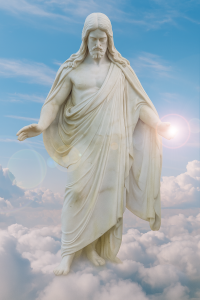Revelation Chapter 1 introduces the revelation of Jesus Christ given to John, often called John the Revelator, which is a critical text in the theology of the Church of Jesus Christ of Latter-day Saints, and the Latter Day Saint Movement as a whole. The chapter sets the stage for the visions and prophecies that follow, revealing key doctrinal elements and symbolic representations.
1 The Revelation of Jesus Christ, which God gave unto him, to shew unto his servants things which must shortly come to pass; and he sent and signified it by his angel unto his servant John:
2 Who bare record of the word of God, and of the testimony of Jesus Christ, and of all things that he saw.
3 Blessed is he that readeth, and they that hear the words of this prophecy, and keep those things which are written therein: for the time is at hand.
4 John to the seven churches which are in Asia: Grace be unto you, and peace, from him which is, and which was, and which is to come; and from the seven Spirits which are before his throne;
5 And from Jesus Christ, who is the faithful witness, and the first begotten of the dead, and the prince of the kings of the earth. Unto him that loved us, and washed us from our sins in his own blood,
6 And hath made us kings and priests unto God and his Father; to him be glory and dominion for ever and ever. Amen.
7 Behold, he cometh with clouds; and every eye shall see him, and they also which pierced him: and all kindreds of the earth shall wail because of him. Even so, Amen.
8 I am Alpha and Omega, the beginning and the ending, saith the Lord, which is, and which was, and which is to come, the Almighty.
9 I John, who also am your brother, and companion in tribulation, and in the kingdom and patience of Jesus Christ, was in the isle that is called Patmos, for the word of God, and for the testimony of Jesus Christ.
10 I was in the Spirit on the Lord’s day, and heard behind me a great voice, as of a trumpet,
11 Saying, I am Alpha and Omega, the first and the last: and, What thou seest, write in a book, and send it unto the seven churches which are in Asia; unto Ephesus, and unto Smyrna, and unto Pergamos, and unto Thyatira, and unto Sardis, and unto Philadelphia, and unto Laodicea.
12 And I turned to see the voice that spake with me. And being turned, I saw seven golden candlesticks;
13 And in the midst of the seven candlesticks one like unto the Son of man, clothed with a garment down to the foot, and girt about the paps with a golden girdle.
14 His head and his hairs were white like wool, as white as snow; and his eyes were as a flame of fire;
15 And his feet like unto fine brass, as if they burned in a furnace; and his voice as the sound of many waters.
16 And he had in his right hand seven stars: and out of his mouth went a sharp twoedged sword: and his countenance was as the sun shineth in his strength.
17 And when I saw him, I fell at his feet as dead. And he laid his right hand upon me, saying unto me, Fear not; I am the first and the last:
18 I am he that liveth, and was dead; and, behold, I am alive for evermore, Amen; and have the keys of hell and of death.
19 Write the things which thou hast seen, and the things which are, and the things which shall be hereafter;
20 The mystery of the seven stars which thou sawest in my right hand, and the seven golden candlesticks. The seven stars are the angels of the seven churches: and the seven candlesticks which thou sawest are the seven churches.
Verses 1-3
Revelation 1:1-3 opens with the declaration that this revelation is from Jesus Christ, given to show His servants things that must shortly come to pass. This highlights the importance of ongoing revelation and the role of prophets in receiving divine guidance. John bears record of God’s word and Jesus Christ’s testimony, underscoring the role of witness and testimony in our faith, where personal revelation and testimony are pivotal.
Verses 4-6
Revelation 1:4-6 addresses the seven churches in Asia, extending grace and peace from the eternal God and Jesus Christ. The “seven Spirits” before His throne can be interpreted as a symbol of the fullness and perfection of the Holy Spirit. The passage affirms Jesus Christ as the faithful witness, the first begotten of the dead, and the prince of the kings of the earth. This shows Christ’s preeminent role in the plan of salvation and His triumph over death, which is fundamental to our doctrines. The reference to being made “kings and priests unto God” resonates with the our belief on the potential for exaltation and becoming joint-heirs with Christ.
Verses 7-8
Revelation 1:7-8 foretells Christ’s second coming, which is a cornerstone of our eschatology. The imagery of Christ coming with clouds and being seen by all demonstrates the universal nature of Christ’s return. The declaration of Christ as “Alpha and Omega” (the beginning and the end) emphasises His eternal nature and role as the Almighty, showing Jesus Christ’s divine authority.
Verses 9-11
Revelation 1:9-11 describes John’s circumstances on the isle of Patmos and his commission to write what he sees to the seven churches. John identifies himself as a brother and companion in tribulation, showing the unity and shared struggles of the early Jewish-Christian community. The command to write to the seven churches signifies the importance of record-keeping and communication of divine messages.
Verses 12-16
Revelation 1:12-16 contains John’s vision of the glorified Christ among seven golden candlesticks, representing the seven churches. The detailed description of Christ—with white hair, fiery eyes, brass feet, and a voice like many waters—symbolises His purity, judgment, stability, and powerful presence. The seven stars in Christ’s right hand, identified as the angels of the seven churches, highlight the guidance and protection provided to the churches.
Verses 17-20
Revelation 1:17-20 concludes with John falling at Christ’s feet and being reassured. Christ’s proclamation of being the first and last, alive forevermore, and holding the keys of hell and death, affirms His victory over sin and death. The explanation of the seven stars and candlesticks underscores the symbolic nature of the vision and the intimate connection between Christ and His churches. The keys of hell and death held by Christ signify His ultimate authority and the power of the Resurrection, which is central to our belief in the afterlife and eternal progression.
In Summary
Revelation Chapter 1 is a profound introduction to the prophetic visions given to John. It emphasises the eternal nature of Christ, the importance of ongoing revelation, the unity and struggles of the faithful, and the ultimate triumph of Jesus Christ over death. The symbolic imagery reinforces core doctrines of the Church of Jesus Christ and the hope of Christ’s return, offering assurance and guidance to members of the Body of Christ.

